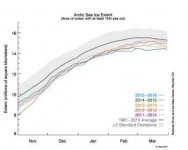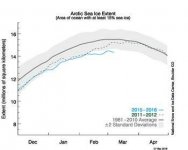Genghis Kush
Active member
http://www.theweathernetwork.com/ne...cap-record-low-after-record-hot-january/63907
"Arctic sea ice at record low, Antarctic far below average
In January 2016 Arctic sea ice extent started off the new year by dropping to its lowest point on record, going back to 1979. This was due, at least in part, to Storm Frank, which was working its way up between Iceland, Ireland and the UK, and bringing plenty of heat and strong winds to the Arctic in the process.
With still a few months before spring and the typical winter peak of Arctic sea ice, there was plenty of time for the extent to reach more normal levels. Indeed, the amount of sea ice did grow again as the storm passed and temperatures through the Arctic returned to something more typical for this time of year.
As of February 1st, however, data from the US National Snow and Ice Data Center (NSIDC) showed that Arctic sea ice extent had, once again, dropped record low levels, and after briefly climbing above levels recorded back in 2005, they once again fell to record low levels as of February 11."
"Arctic sea ice at record low, Antarctic far below average
In January 2016 Arctic sea ice extent started off the new year by dropping to its lowest point on record, going back to 1979. This was due, at least in part, to Storm Frank, which was working its way up between Iceland, Ireland and the UK, and bringing plenty of heat and strong winds to the Arctic in the process.
With still a few months before spring and the typical winter peak of Arctic sea ice, there was plenty of time for the extent to reach more normal levels. Indeed, the amount of sea ice did grow again as the storm passed and temperatures through the Arctic returned to something more typical for this time of year.
As of February 1st, however, data from the US National Snow and Ice Data Center (NSIDC) showed that Arctic sea ice extent had, once again, dropped record low levels, and after briefly climbing above levels recorded back in 2005, they once again fell to record low levels as of February 11."






